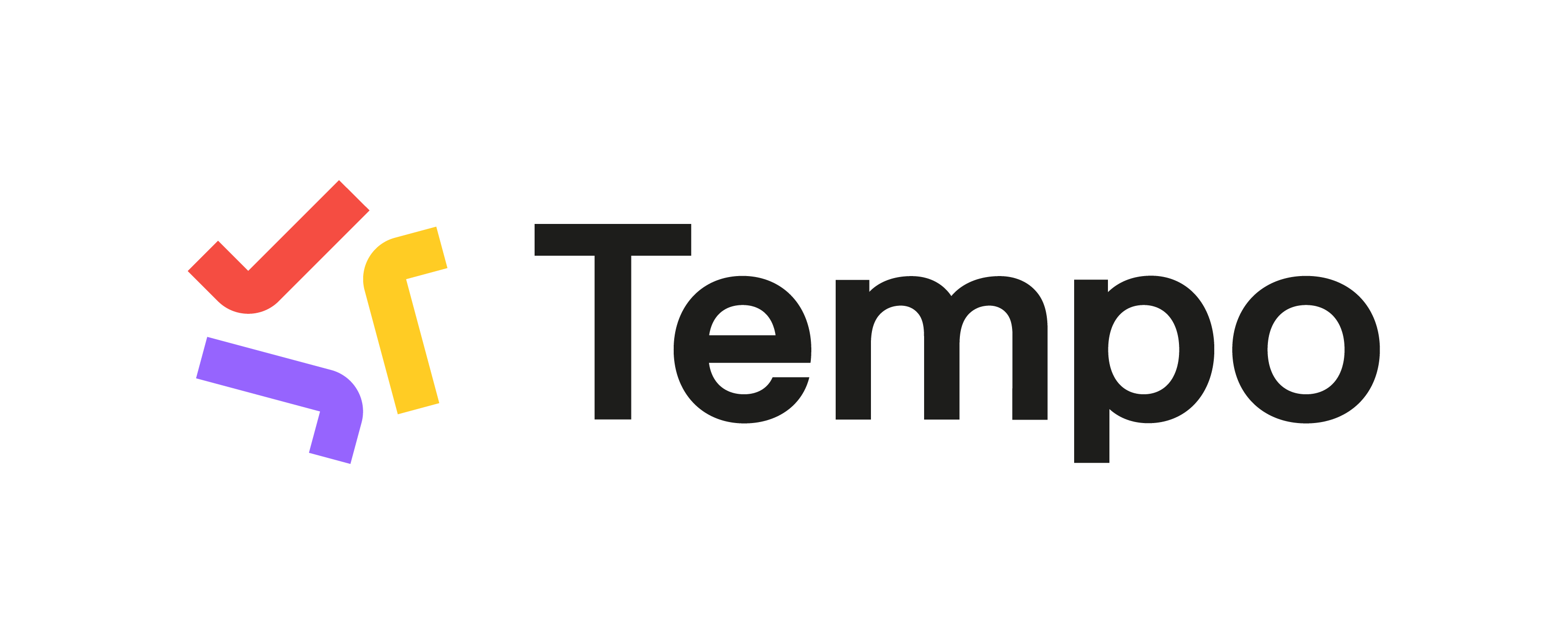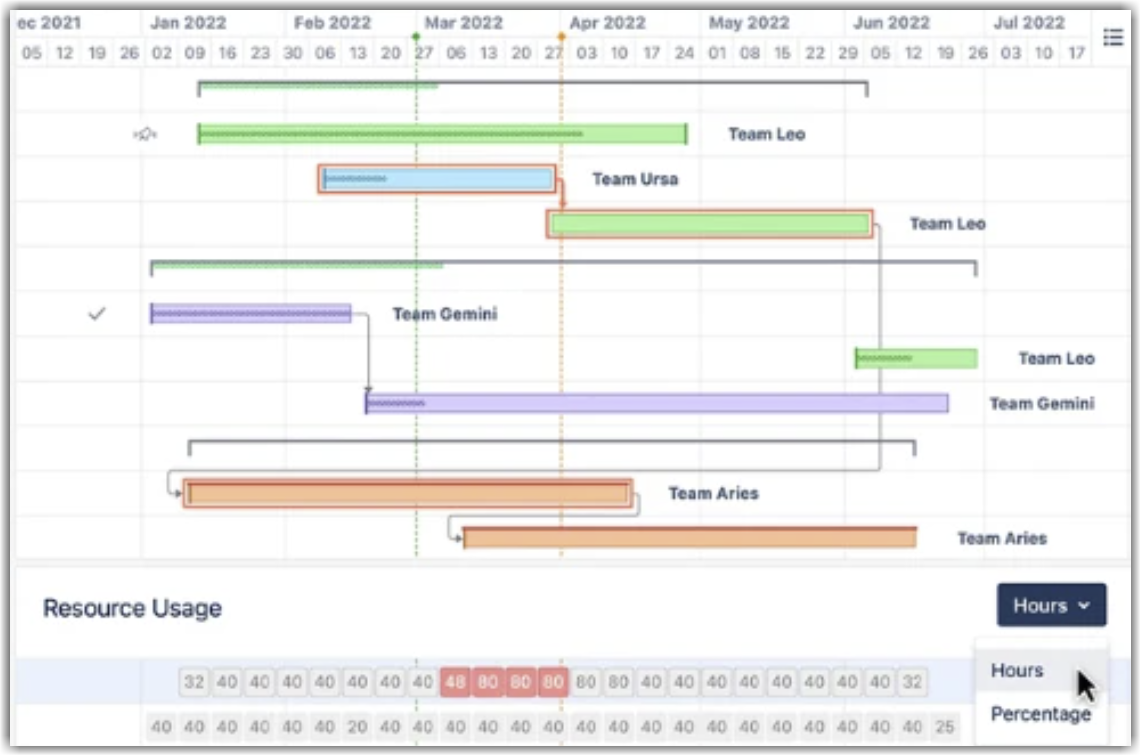Custom Reports
With Structure, you can easily create a visual overview of your projects – and visualize all the data you need to track on a single screen.
Step 1: Build Your Structure
To create a new structure:
-
Open the Structure Selector menu and select Create New Structure
-
Use the +Add menu to add work items and build your hierarchy:
-
Use Presets to use one of Structure's preconfigured hierarchies
-
Or configuring your own hierarchy using +Add | Insert | Basic Insert, +Add | Group, and +Add | Extend
-
Step 2: Add Data
Next, add the data you need to track by clicking the + button at the top-right corner of the structure. You can add as many columns as you need, including:
-
Jira Fields - For each Jira field, Structure offers a column that displays that field's value.
-
Progress - Display an aggregate work item progress, which is calculated based on values from the work item and its sub-work items.
-
Totals - Display aggregate values for work item progress, which include progress values from sub-work items.
-
Service Management - Jira Service Management customers can visualize and manage SLA fields within a structure.
-
Work Logged - View and manage Timesheets by Tempo work logged data alongside your project data.
-
Many more - To learn more about the available columns, see Adding Columns.
Once you've added your columns, you can aggregate the data up the structure. To do so, open the column you want to aggregate and select Sum over sub-items.
Looking to visualize your structure data as a chart or other report? Our integration with Custom Charts for Jira makes it easy to build customizable charts from your structure data. Learn more
Objectives and Key Results (OKRs)
Create a structure to organize and track Objectives and Key Results across all your Jira spaces.
Step 1: Build an OKR Project in Jira
We recommend adding 2 work types to your space:
-
Objectives - the Parent items
-
Key Results - the Child items
Step 2: Add Objectives to the Structure
-
Create a new structure using Power mode
-
In the new structure, go to + Add | Insert | Basic Insert
-
Configure the following:
-
Space: <Select your OKR project>
-
Work Type: Objective
-
-
Click Create
Step 3: Add Key Results
-
Go to + Add | Extend | Child Work Items
-
Configure the following:
-
Check the Work Items under epics box
-
Check the Moving an item in the structure will change its parent work item in Jira box
-
Extend levels: 1 to 5
-
-
Click Create
Step 4: Add Epics
-
Go to + Add | Extend | Linked Items
-
Configure the following:
-
Link type: Add the link type you use to connect your epics to key results (we used Implements, but you may prefer another link, such as Relates to, etc.)
-
Check the Moving items in the structure will update links box
-
Extend levels: 2 to 2
-
You don’t have to use Epics for these - add whatever type of work item your team uses to track key results (tasks, stories, etc.).
Once you add your epics, you should see any child stories/tasks automatically added beneath them - this is because of the Extend Child Work Items generator we added in Step 3.
Step 5: Link Epics to Key Results
If you’ve already linked epics to key results in Jira, you should see those in the hierarchy. If not, or if you want to add more, here’s an easy way to link epics to key results:
-
Create a structure that contains the epics you want to link to your key results (or use one you already have!)
-
Select Split in the Structure toolbar to open a second structure panel
-
In the left panel, open the OKR structure
-
In the right panel, open the structure with your epics
-
-
Drag epics from the right panel under the appropriate Key Result in the left panel - this will automatically add links between your key results and epics (if it doesn’t, open your Extend Linked Items generator and make sure the Moving items in the structure will update links box is checked)
If an epic affects more than one key result, you can place it under as many key results as necessary and have its data reflected for all of them!
Step 6: Add Data
Next, add the data you need to track by clicking the + button at the top-right corner of the structure. You can add as many columns as you need, including:
-
Jira Fields - For each Jira field, Structure offers a column that displays that field's value.
-
Progress - Display an aggregate work item progress, which is calculated based on values from the work item and its sub-work items.
-
Totals - Display aggregate values for work item progress, which include progress values from sub-work items.
-
Service Management - Jira Service Management customers can visualize and manage SLA fields within a structure.
-
Work Logged - View and manage Timesheets by Tempo work logged data alongside your project data.
-
Many more - To learn more about the available columns, see Adding Columns.
Once you've added your columns, you can aggregate the data up the structure. To do so, open the column you want to aggregate and select Sum over sub-items.
Release Management
With Structure, you can track all the work items for upcoming releases – even if they're from different spaces – and visualize all the data you need to track on a single screen.
Step 1: Build a Release Management Structure
To create a structure for release management:
-
Open the Structure Selector menu and select Create New Structure
-
Add the work items you want to track – you can add them manually or automatically using +Add | Insert | Basic Insert
-
Group work items by fix version: +Add | Group | Field | select "Fix Version/s"
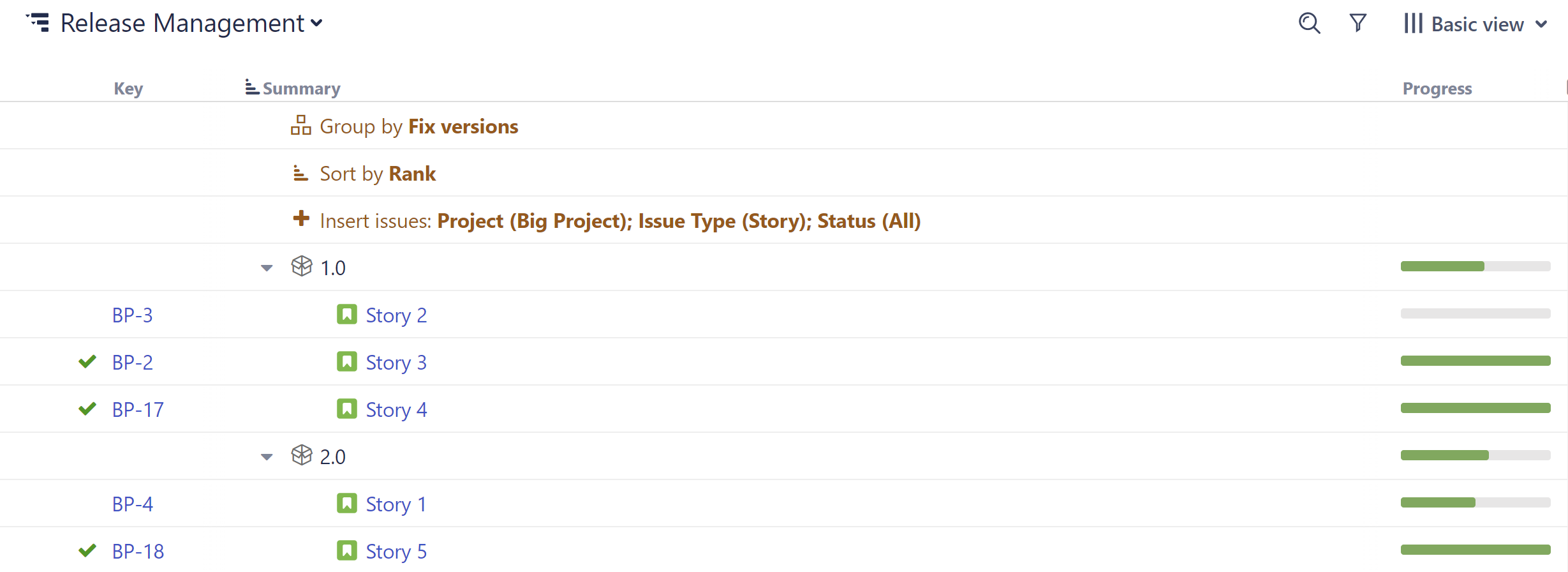
Want to include epics and stories?
-
When inserting work items, add epics: +Add | Insert | Basic Insert | open the Issue Types dropdown and select Epic
-
Add your stories: +Add | Insert | Child Work Items | under Add, select Work Items under epics and (optional) Sub-tasks.
Step 2: Add Data
Next, add the data you need to track by clicking the + button at the top-right corner of the structure. You can add as many columns as you need, including:
-
Jira Fields - For each Jira field, Structure offers a column that displays that field's value.
-
Progress - Display an aggregate work item progress, which is calculated based on values from the work item and its sub-work items.
-
Totals - Display aggregate values for work item progress, which include progress values from sub-work items.
-
Service Management - Jira Service Management customers can visualize and manage SLA fields within a structure.
-
Work Logged - View and manage Timesheets by Tempo work logged data alongside your project data.
-
Many more - To learn more about the available columns, see Adding Columns.
Once you've added your columns, you can aggregate the data up the structure. To do so, open the column you want to aggregate and select Sum over sub-items.
Looking to manage resources for your next project? Planner makes it easy to plan resources and capacity for your team.
Resource Allocation
When team members are working on multiple projects, it can be difficult to track how much work everyone is doing. Using Structure, you can track allocation across projects and reassign work on the fly.
Step 1: Build a Resource Allocation Structure
Insert work items from every space/board the team members work on, and then group them by Progress and Assignee.
To create a new structure:
-
Open the Structure Selector menu and select Create New Structure
-
Add all the work items: +Add | Insert | Basic Insert
-
Group work items by Status: +Add | Group | FIeld | select "Status"
-
Group work items by Assignee: +Add | Group | Field | select "Assignee"
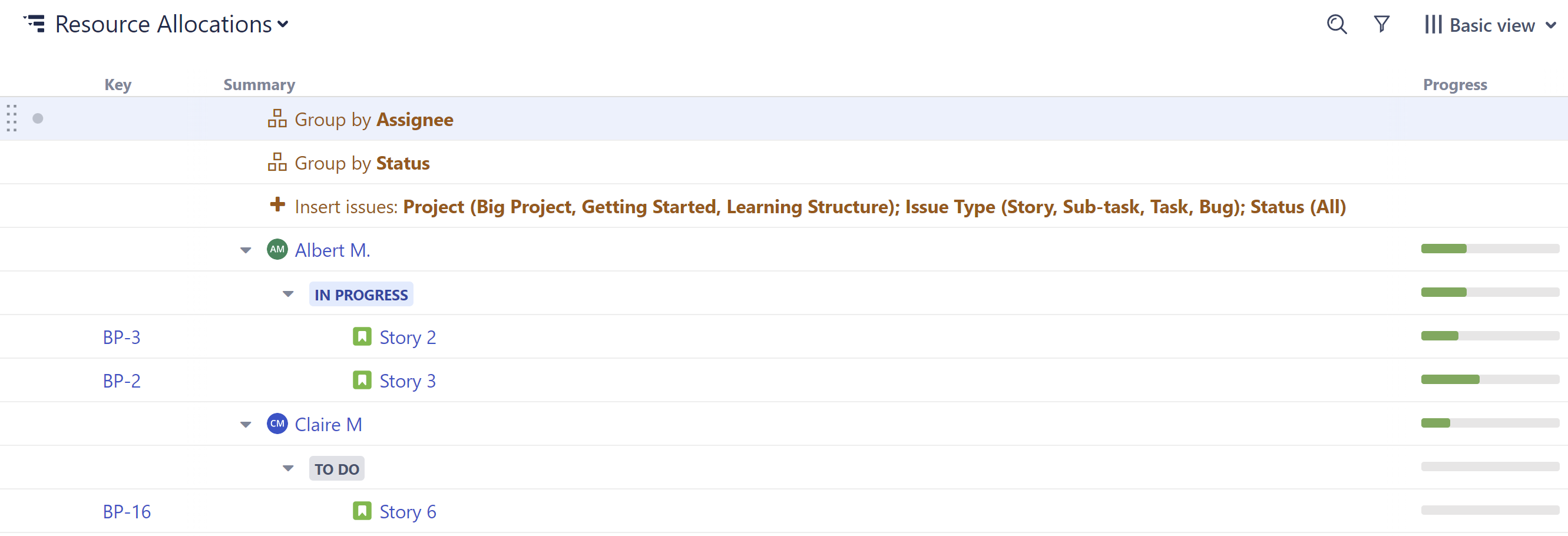
If the status is appearing above the assignee, drag the "Group by Status" row under the "Group by Assignee" row.
This will create a grouping for every team member with at least one work item in the current structure assigned to them. If someone doesn't have any work items assigned to them, they won't appear here. To fix this, simply assign an unassigned work item to that team member, and a new grouping will appear.
Step 2: Add Columns to Compare Workloads
Structure columns allow you to visualize multiple data points in a single view. We recommend one or more of these:
-
Status
-
∑ Story Points (if you’re using them)
-
∑ Original Estimate
-
∑ Remaining Estimate
-
A custom formula to calculate the remaining effort
Using a Totals columns, the values for individual work items are aggregated up to their assignee, so you can evaluate workloads at a glance. 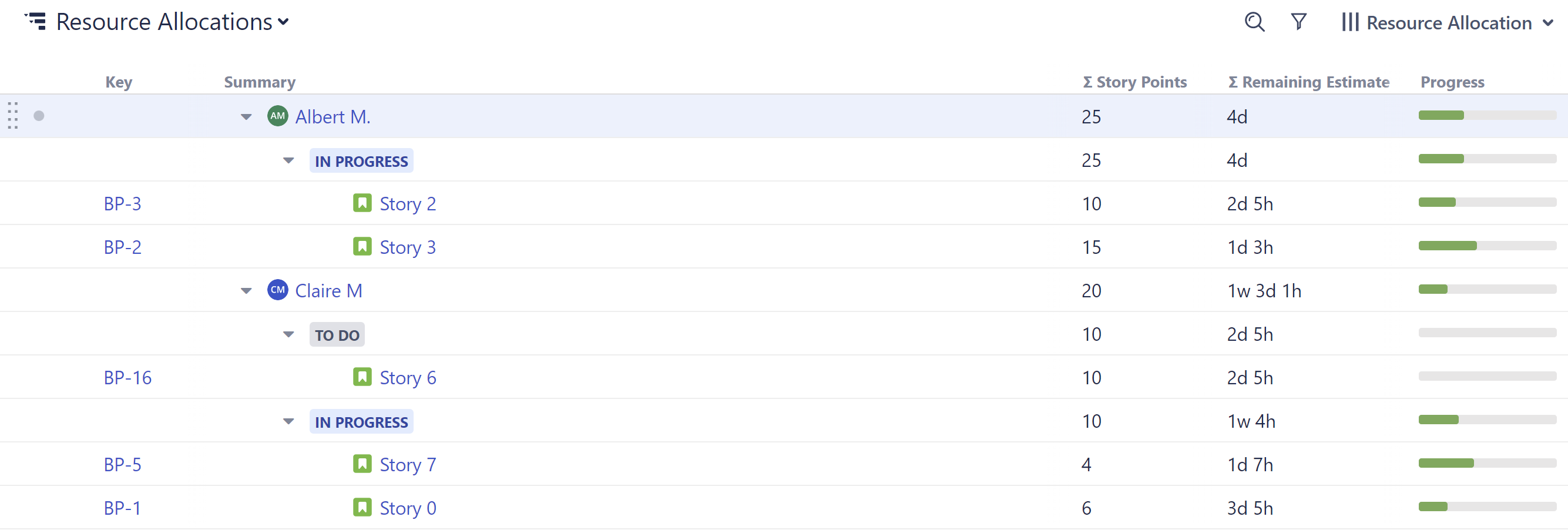
Step 3: Drag Work Items to Reassign
To assign/reassign tasks, simply drag work items from one assignee grouping to another.
Optional Enhancements:
-
To allocate resources at the group level, group work items by a custom Team field instead of Assignee.
-
Add a WSJF column to prioritize work items, and select Sum over sub-items to balance priorities across resources.
-
Manage allocation across sprints by adding a Group by Sprint generator. (Haven't assigned sprints yet? Check out Sprint Planning with Structure!)
-
Try Planner by Tempo to plan resources and capacity for your team.
Adding Structure.Gantt makes it easy to identify and resolve overallocations across projects and portfolios.
Sprint Planning
With Structure, you can track all the work items for upcoming sprints – even if they're from different spaces – and visualize all the data you need to track on a single screen. You can even aggregate that data for each sprint.
Step 1: Build a Sprint Planning Structure
To create a new structure:
-
Open the Structure Selector menu and select Create New Structure
-
Add work items: +Add | Insert | Basic Insert
-
Group work items by fix version: +Add | Group | Field | select "Sprints"
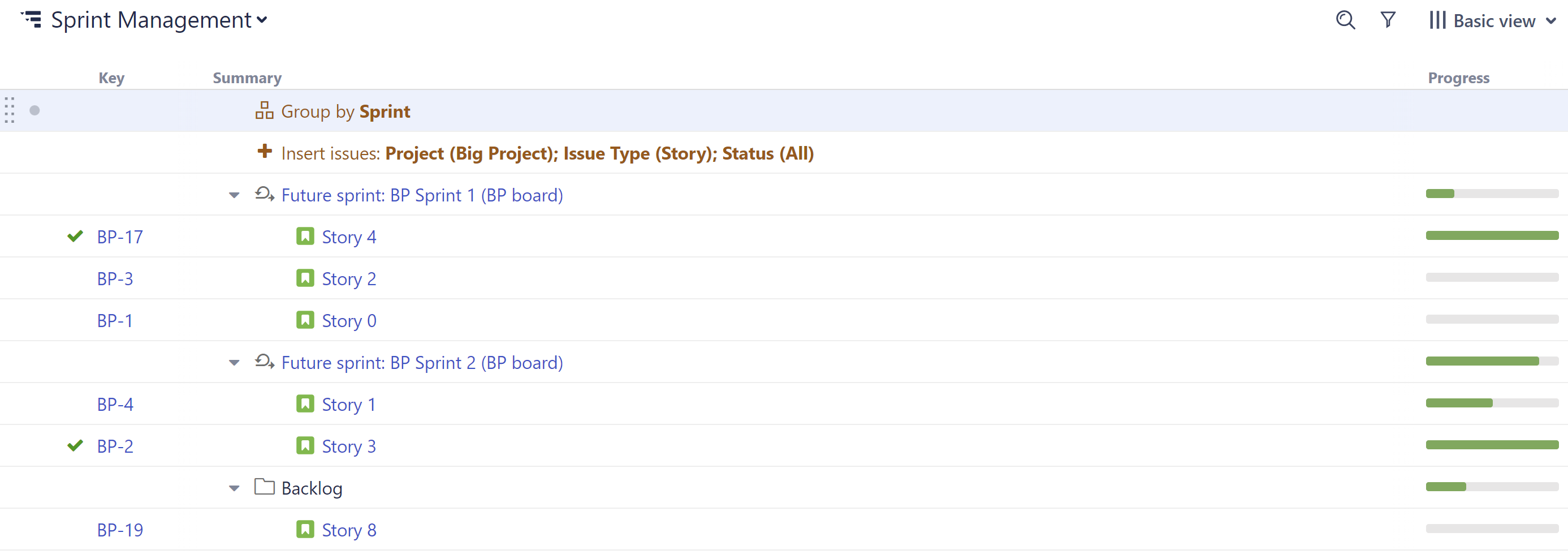
Step 2: Add Data
Next, add the data you'll use to compare work item priority:
-
Click the + button at the top-right corner of the structure
-
Select the fields or attributes you want to compare - we recommend:
-
Status
-
Assignee
-
Epic
-
Story Points (if you’re using them)
-
WSJF (or any other metric your team uses to prioritize work items or assess business value)
-
-
Click the header of any column to sort your work items by that value.
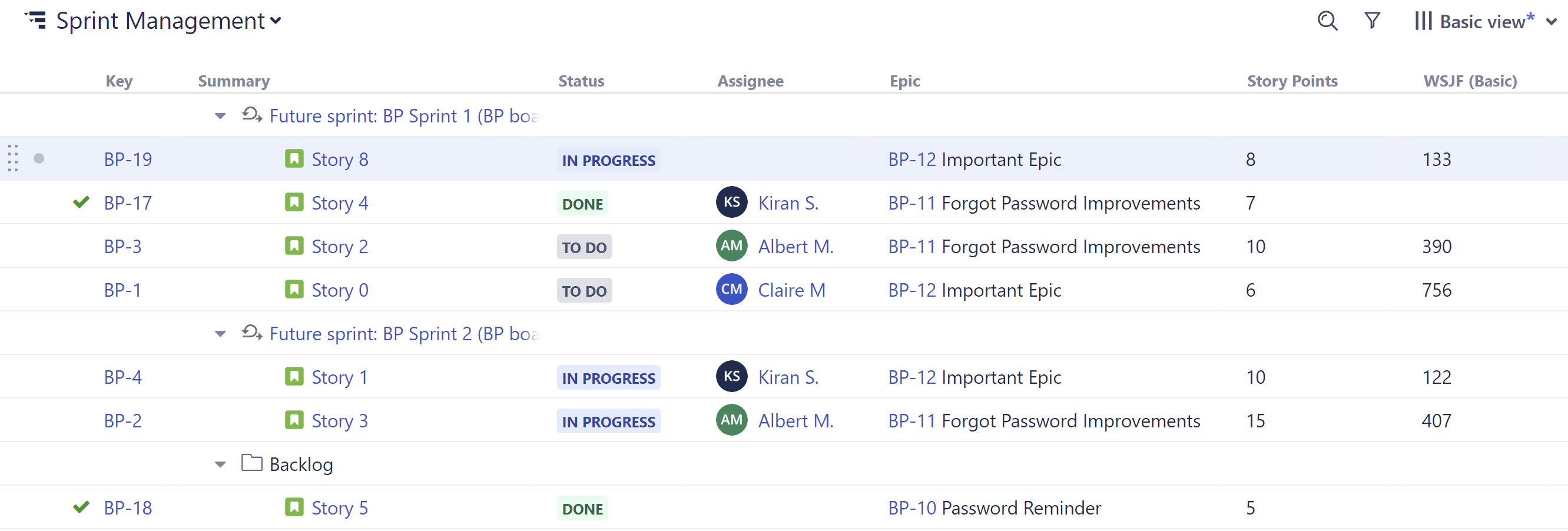
Step 3: Assign Work Items
To assign work items to a sprint, drag it from the backlog to the appropriate sprint. You can also reassign work items by dragging them from one sprint to another. 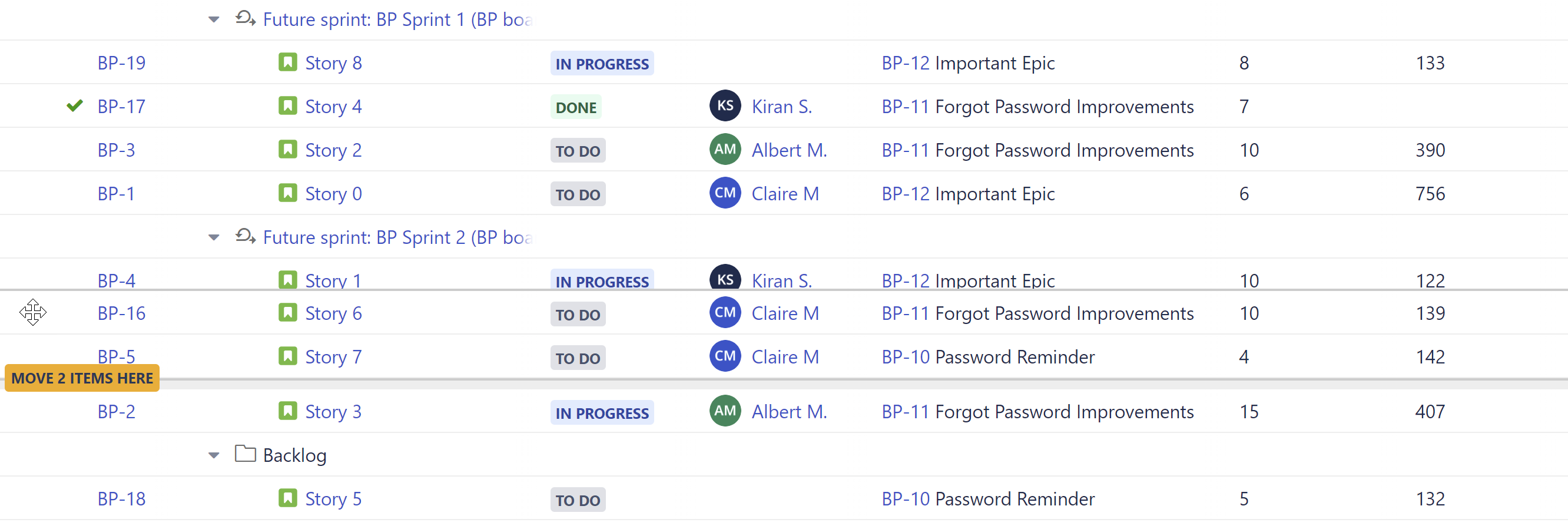
Optional Enhancements
-
Aggregate values for each sprint: when adding a column (such as Story Points), select Sum over sub-items
-
Group by assignee under each sprint to see how the work is divided across your team: +Add | Group | Field | Assignee
-
Use Structure.Gantt to view any blocking dependencies between work items (to help prioritize them)
Strategic Portfolio Management
Tempo's Strategic Portfolio Management solution is a modular approach to help organizations focus their priorities, people, and spend across their portfolio of products and services.
-
Plan and manage your work in Structure.
-
Convert your plans into boardroom-ready roadmaps in Strategic Roadmaps.
-
Monitor the financial health of your portfolio using Financial Manager and Structure.
-
Manage resources and resource allocation with Capacity Planner and Gantt Charts for Structure.
-
Build custom reports to monitor your portfolio with Custom Charts.
The following products are part of Tempo's Strategic Portfolio Management solution. Pick the ones that are right for your teams, or try them all - you can download free trials using the links below.
Strategic Portfolio Management with Tempo Apps
